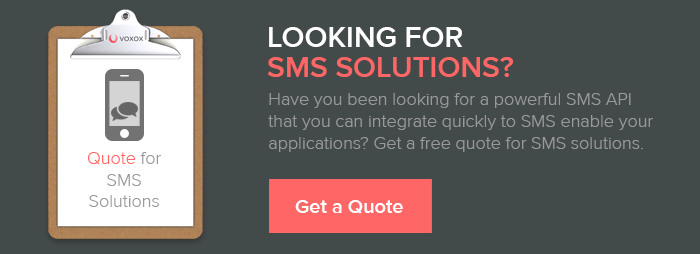 98% of text messages are read, compared to 22% of emails, 29% of tweets and 12% of Facebook posts (source: Frost & Sullivan). So why wouldnt a business SMS-enable as much of their products and communications as possible?
98% of text messages are read, compared to 22% of emails, 29% of tweets and 12% of Facebook posts (source: Frost & Sullivan). So why wouldnt a business SMS-enable as much of their products and communications as possible?
While it sounds simple, theres actually a lot going on behind the scenes when you send a text message. If you think about it, there are hundreds of mobile operators around the world. Some receive messaging in binary format, while others via the ASCII format. Furthermore, say a person recently changed from one carrier to another this is also something that a service delivery platform must be able to detect in order to convert messages appropriately. And what if a persons phone is turned off? Something else to be aware of so that the message can be held until the phone has been turned back on. Or, what if the message sent is too long for a text message? This too must be identified so that the message could be split into the right number of shorter messages in order to comply with the proper SMS character count.
You get the point. With all these scenarios to consider, how can a company with no previous experience in text messaging delivery operate at the level of a global carrier? Well, thats where the magic of an SMS web service API comes in!
SMS is sent via a protocol called SMPP, which is not easy to integrate into software. So, an SMS web service API is critical to convert messages to the proper format for texting. And as with all services, theres a range of possibilities. There are three key areas to evaluate when selecting an SMS web service API:
1. Quick & Easy Deployment
For developers, the most popular protocol for exchanging data between web-based computer systems is REST, which stands for Representational State Transfer. Its an architectural style that is flexible enough to incorporate into any type of software, which is why SMS web service APIs that use this standard are easiest for developers to work with. This allows them to utilize any environment they chose, such as PHP. (If they had to work with SMPP - different story.)
When looking for an SMS web service API solution, its most convenient to use a provider which has an SMS service center that takes requests in REST format and converts them into SMPP. Its also important to ensure that the solution is straightforward and well-documented. With the right SMS web service API, a customer can be set up to send and receive text messages in a matter of minutes!
2. Rock Solid Infrastructure
When selecting an SMS web service API, its important to look for an endtoend solution thats designed to address the needs of businesses looking to SMSenable their products, services and customer communications. A critical factor for this type of solution is an SMS service providers access to a high-load, redundant network infrastructure thats making use of multiple bandwidth sources and geographically redundant hardware. For example, Voxoxs SMS web service API clients regularly send more than 200 text messages per second thats 6 million messages per 8 hour workday! Its very important that each message goes where its intended. Hence, in an ultra high availability data transaction environment, you want a reliable system that maintains a 99.999% uptime.
3. A Good Deal
Quality and convenience are important, but everyones got a budget to work with. Hence pricing is another key factor when evaluating an SMS web service API. Sliding scale pricing that takes volume into account can be very effective in this scenario. Also, you may be able to cut costs if youre working with a company that has carrier status (for example you can check to see if they are a CLEC or competitive local exchange carrier) because such a company has direct carrier relationships with other global carriers; hence, youre not paying a premium for going through a middleman. Such SMS service providers can also offer more features for their SMS solutions, such as the availability of 2-way SMS for their phone numbers (or DIDs), or having voice tied to phone numbers, in case you want an end-user to be able to call back regarding an SMS notification.
And there you have it! When you need to find a way to handle large volume message delivery, look for an SMS web service API thats easy to work with, requires no special knowledge of SMS, and is reliable with top notch infrastructure and capacity to scale. Then, when you narrow down your list to providers that fit this criteria, shop around to make sure youre getting a good deal!







